Marketing optimisation is key to driving more high-quality leads for less budget. In this blog, we share how Ruler Analytics can help you to optimise all facets of your marketing and drive better results.
Driving leads is a major challenge for marketers. In fact, in our recent report into marketing attribution and reporting, we found that nearly 40% of marketers find generating high-quality leads a challenge.
So how can Ruler help?
Well, here’s a quick guide into what we’ll cover:
Let’s get started!
Before we dive into how to track customer journeys, we need to first understand them. We’ve all heard of the buyer’s journey, right?
Plotting this and being able to break it down is key to understanding how content and channels move users from start to end.
A customer journey it’s how a potential customer moves from a prospect to a customer thanks to your marketing content.
Now the issue with customer journeys is that they’re getting longer. Just think about how many marketing channels you use for one.
Our recent report found marketers are using as many as 13 channels. Think then about how many times a customer needs to engage with your content before converting.
It’s highly unlikely a user will see your website for the first time, and convert right away.
Related: Average conversion rate benchmarks by industry
So, chances are you’re dealing with a huge number of marketing touchpoints.
That’s an awful lot of data you need to make sense of.
Hundreds of touchpoints is going to be tricky for any marketer to track. How do you identify the same user across multiple different channels?
Well, this is where Ruler comes in.
You might already know, but Ruler is a marketing attribution tool.
Related: Complete guide to marketing attribution and models
It works like so:
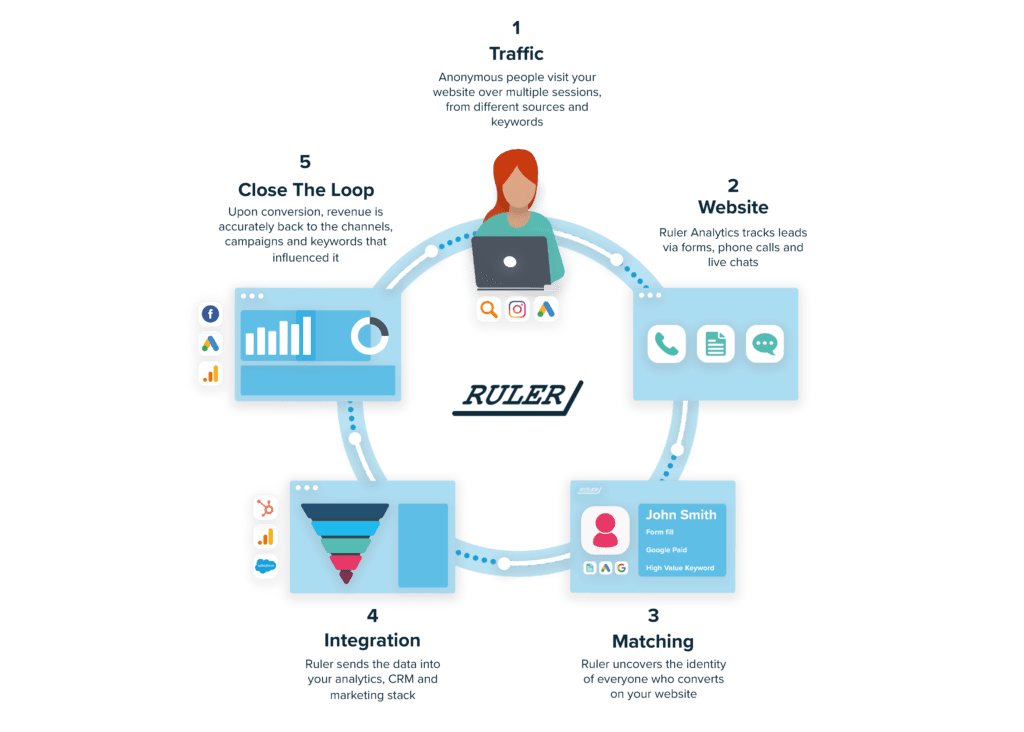
A user visits your website for the first time.
Ruler tracks all of the necessary lead and marketing data. This user doesn’t convert first time, but instead visits you via lots of different sources four more times. On each visit, they engage with different pages and blogs on your website.
Ruler tracks it all.
Then, when they convert, Ruler fires all of the data held on that user to your CRM.
Related: How to send lead source data to your CRM
You’ll be able to see their true lead source, as well as other key data like inbound call information, or form fill data.
But it doesn’t stop there.
Ruler continues to track your lead.
When they convert into a sale, whether it takes a month, or a year, Ruler will scrape the revenue data from that user in your CRM and fire it to your analytics tools.
There, it will be correctly attributed to the corresponding channels, campaign, ad, keyword etc.
📈 Pro Tip
Want to learn more about getting revenue data in your measurement tools? Read our complete guide to unlocking revenue data in Google Analytics
It means you’ll be able to see how much revenue your marketing is generating no matter if a user engages with your 500 times, converts offline and more.
Tracking your leads and website visitors with Ruler Analytics gives quite a few key benefits.
They include:
Let’s go through them one by one.
How many times have you tried to view a lead source and seen ‘direct’?
This is a huge frustration for marketers because it doesn’t give a true indication of how their channels are helping to drive new leads.
Let’s use an example.
John becomes a lead by calling your business. Even if you do have call tracking in place, the session he calls you from is a direct referral. So that doesn’t tell your marketing team much about how he found you.
With Ruler, you’ll be able to see his first interaction with you was actually via organic search.
And, if you log into Ruler itself, you’ll be able to see his full customer journey, which looks a little like this.
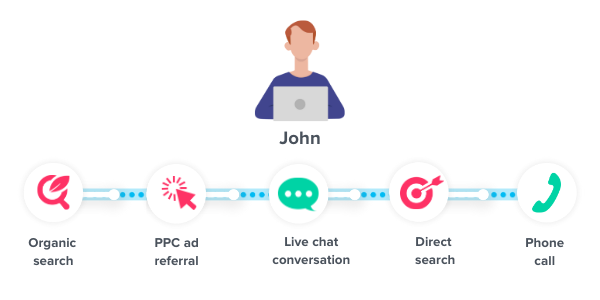
So, with Ruler’s help, you can understand your full customer journeys and how channels play particular roles in starting or driving customer journeys.
Related: Does self-reported attribution really work?
So we know that Ruler can allow you to view full customer journeys.
But you can also use different attribution models which means you can see the roles channels play using your preferred model type. And there’s no reason to stick to just one, either!
Related: Guide to marketing attribution modelling
Let’s use another example.
Sara clicks on a PPC ad you set live and engages with your website.
As Sara is a new visitor to your website, Ruler scrapes her data including valuable marketing details.
Sara returns to your site a few days later via a Facebook remarketing advert.
Again, she engages with your content but she doesn’t convert.
Sara returns for the third time via an organic search. After viewing your product pages or blogs, she converts via a form fill.
She eventually closes into a sale.
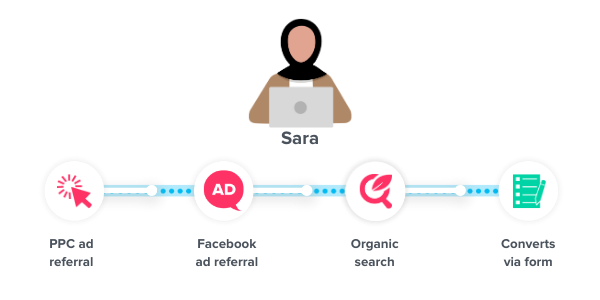
Now let’s look at this from an attribution model perspective.
For first-click, all of the credit would be assigned to the PPC ad she engaged with.
That’s great from a ROAS perspective. From a last-click perspective, all of the credit would be assigned to your organic content.
Notice there’s no credit in either of these model types for the Facebook advert.
But what about linear? Here, all the channels receive an equal split of the credit. And in time decay, credit will be weighted towards the beginning of Sara’s customer journey.
In Ruler, you can switch between attribution model types in order to get a better overview of what’s working well and what isn’t.
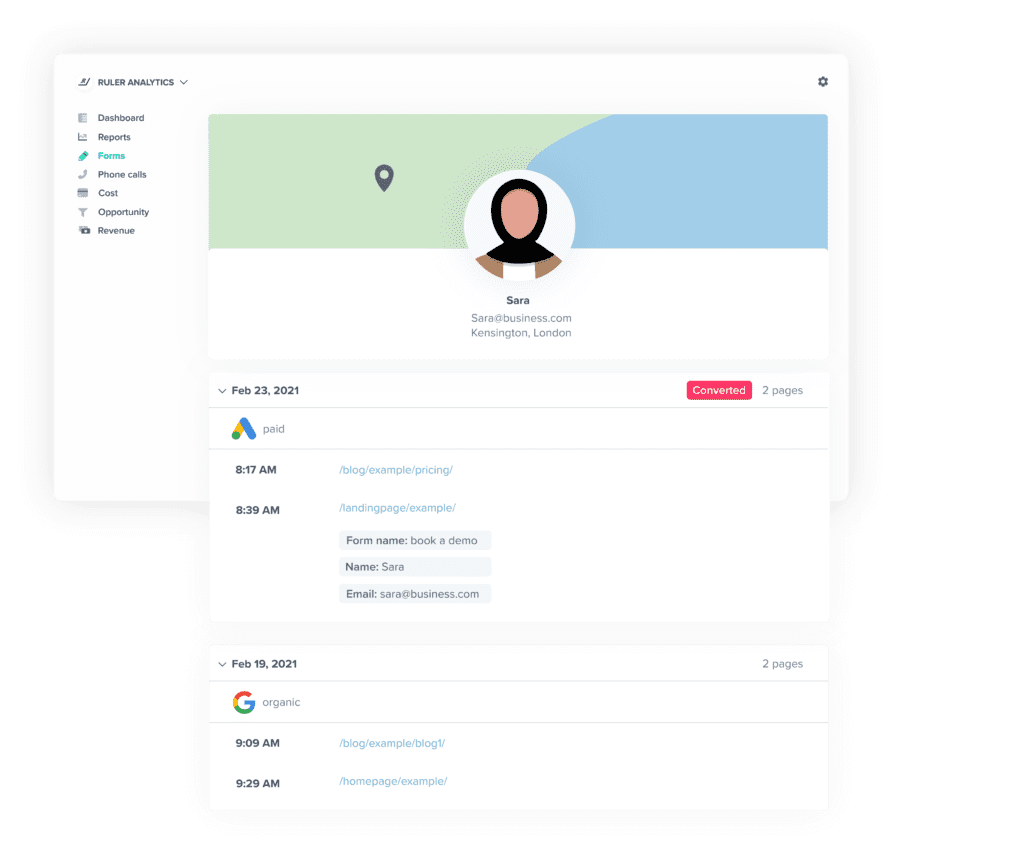
While you might find PPC is working well from a first-click perspective, you might find that under a different attribution model type, Facebook ads are driving customer journeys too.
It’s this visibility that allows you to make smarter decisions about your marketing.
Alongside a full customer view comes micro conversions.
While you’re exploring how attribution models affect the revenue generation per channel, you can also identify micro conversions.
You can start spotting trends as you’re playing with attribution models on the source report.
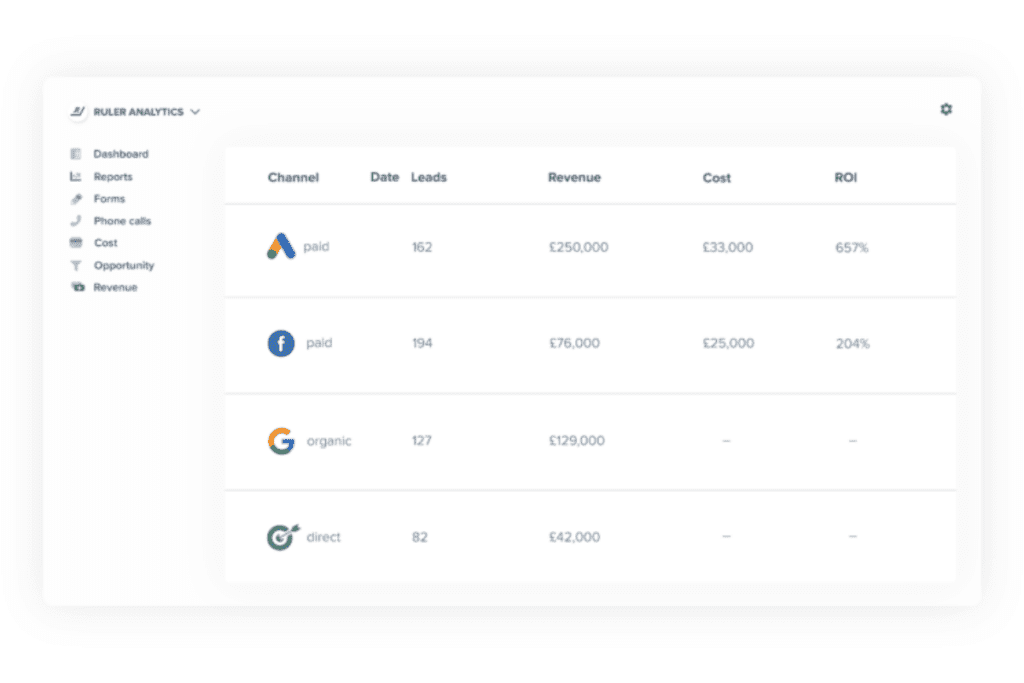
Using our example before, you’d notice the revenue change as you moved from first-click to last-click and to linear.
By understanding the attribution model types, you can start to recognise patterns. Read our full guide to attribution and the model types here. Or, sign up for our free e-learning platform and get certified in attribution.
For example, if you see PPC is high when on first-click, then it’s clear your ads are working well to start new customer journeys.
Meanwhile, if you swap to linear and Facebook ads and email show up as revenue-generating channels, then you know that these are playing a key role in continuing customer journeys.
We all know that organic and SEO content is important in marketing.
We all have different targets and goals when it comes to channels and campaigns.
But there’s a lot to be gained by doing well on organic.
Organic content is a key channel for many businesses. Getting found organically on your target keywords and phrases is a great way to get eyes on your business. But optimising your organic content can often be tricky.
Don’t get us wrong, Google Analytics is a fantastic tool for measuring your website performance, particularly your organic traffic.
But there aren’t huge amounts of insights for marketers.
Related: The limitations of Google Analytics
While checking bounce rate, time on page and sessions is key for understanding how your page is functioning, what about how it performs as part of a larger customer journey?
Even if you have eCommerce capabilities, you can’t always properly attribute revenue back to an organic session six or seven sessions ago.
That’s where Ruler comes in. Let’s look at how our reports can help you optimise your organic content.
Revenue isn’t the only marketing metric, but it is the most important. And while it’s important to track other metrics, the conversion potential of your landing pages is key.
Ruler’s landing page report allows you to see not only the traffic to your pages but also the leads generated from it, as well as the revenue and lead to close rate.
Take a look at the lead generation, revenue generation and lead to close rate for your landing pages to find out which ones are working well to bring you new revenue.
If you find pages are driving lots of leads, but have low closing rates then you need to look into your sales process to understand if there’s an issue with lead quality.
And, if you find that pages are driving low leads, but those leads are converting well into revenue, then you need to look into how you can drive more traffic to that page.
Let’s say you find a landing page that’s driving a lot of leads and has a good lead to close rate.
This is the perfect page to drive more traffic to.
So, all you need to do is work out how to get more traffic on to that page so you can generate more leads.
And what about pages that are high traffic?
Well, it could be that they’re just working from a first-click perspective so we don’t expect a huge number of direct conversions from that page.
Or, it could be an opportunity to add some strong CTAs in your page either to close a visitor, or to drive them further down the funnel.
By understanding the stage your content is in, you can optimise it to help improve your overall funnel.
So, to recap that’s:
Given Ruler pushes closed revenue to your analytics tools, you can also log into Google Analytics to view closed revenue by channel, campaign and landing page.
It’s a great way to view which pages are working hardest to drive new high-quality leads.
Related: Guide to Google Analytics attribution
Viewing your acquisition report in Google Analytics means you can see which channels are worth investing in and which aren’t.
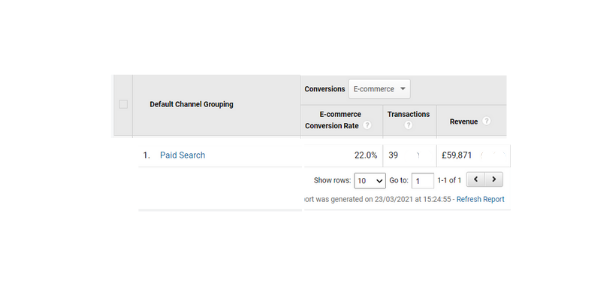
From there, you can decide which ones to prioritise in terms of budget and resources. If organic crops up as a top performer, then you’ll know how to optimise your landing pages.
We wrote a whole blog on how to optimise your paid campaigns. But don’t worry, we’ll recap all the main points for you here.
Paid advertising can be costly. So you want to make sure if you’re investing, that you’re investing wisely. Just like organic content, it becomes trickier to track results when users are converting via form fills, phone calls and live chat, and when customer journeys are so long.
But, there’s light at the end of the tunnel. Ruler Analytics is the key to closing the data disconnect.
Using Facebook and Google simultaneously and not sure which is working better?
With Ruler’s source report, you’ll be able to prove which source is driving:
Plus, with Ruler’s cost functionality, you can automatically pull in the ad cost.
With this Ruler can calculate and share key metrics like cost per lead, cost per acquisition, ROI and ROAS.
Identifying which channel is driving more for its money is key to optimising your paid budgets.
It means you can test on channels you use less often, and it could mean you identify a more lucrative channel to share paid ads on.
When using paid channels to drive traffic, leads and sales, you’re likely using UTM tags on your links.
This is a recommended tactic in order to get better overview of how your marketing is working as you can break it down by campaign, medium and content.
And, if you’re using Ruler, there’s a report for each!
The campaign report allows you to break down your ad performance by individual campaign.
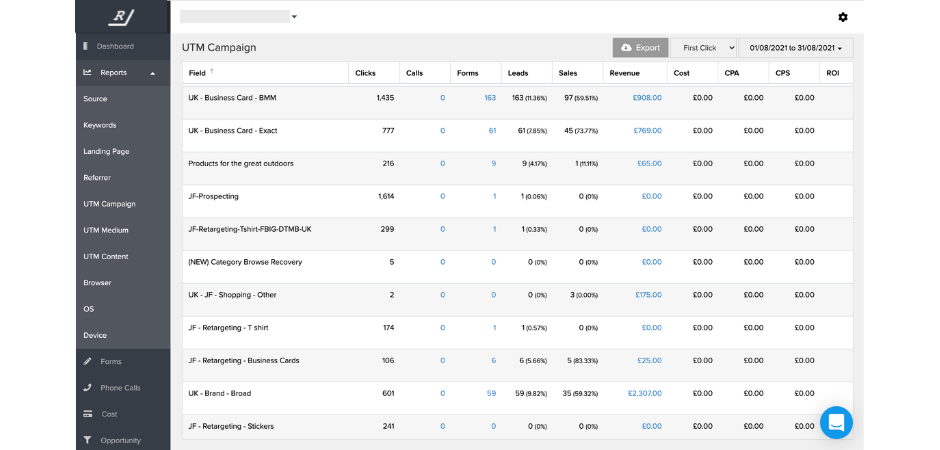
So, even if you’re running a campaign across Bing, Google, Instagram and Facebook, you’ll still be able to corroborate that data in one report.
As always, you’ll be able to see traffic data, along with lead and conversion data.
This data quickly illuminates what’s working best, and what isn’t.
The same applies to the medium and content reports.
Use them to differentiate between your ad success and make smart decisions using real insight based on sales, not leads.
With Ruler’s tool, you’ll be able to see which keywords in your campaigns are driving the most leads and revenue (plus CPL, CPA, ROI and ROAS).
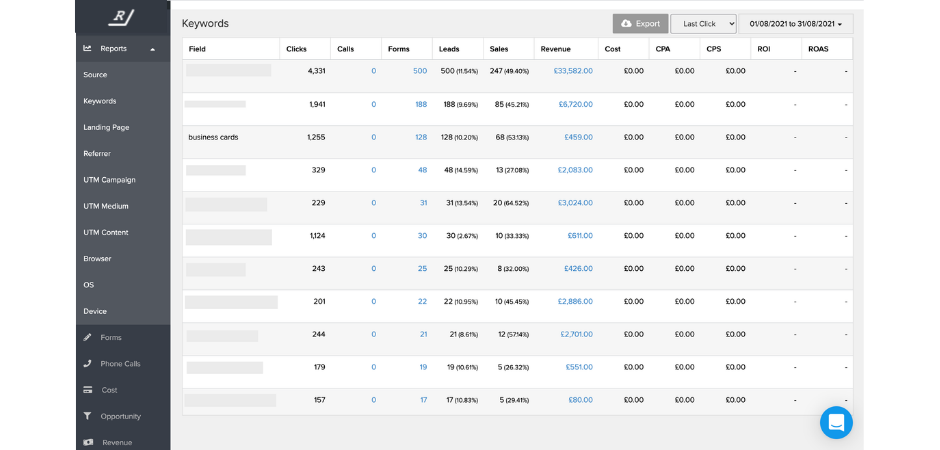
You might find a keyword is driving a lot of traffic but users aren’t converting.
Perhaps you need to evaluate your landing page. Is something stopping them from converting?
Or perhaps you find a keyword that’s driving traffic and leads, but not sales.
One of our clients had this very issue. They used Ruler’s callback capability to dive deeper into why these leads weren’t converting.
Turns out, users search intent (though matching the keyword) was completely different to the intent set by the ad manager.
While it was a similar product, it wasn’t exactly the right fit. So those coming through as leads via this keyword were not the company’s intended audience.
They turned the keyword off in their ads manager and watched their stats increase.
This insight allowed them to save thousands of pounds on low-quality leads.
If you made it through this far, well done! It’s no mean feat reading a 2,000+ word blog.
Hopefully, this helped you better understand how Ruler can help optimise your marketing and improve your results.
If you’re not already using Ruler, then why not? It’s easy to set up and easy to use, meaning tangible, real-time results at the ends of your fingertips.
Book a demo with our team or read more about how Add People use Ruler to get true visibility of their website visitors and how they used these insights to increase their lead generation by 400%.
And remember, you can learn more about attribution with our free course. Enrol in Attribution Academy to get ahead of the pack!